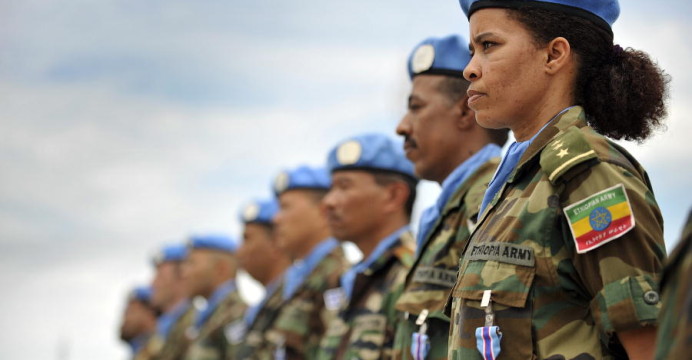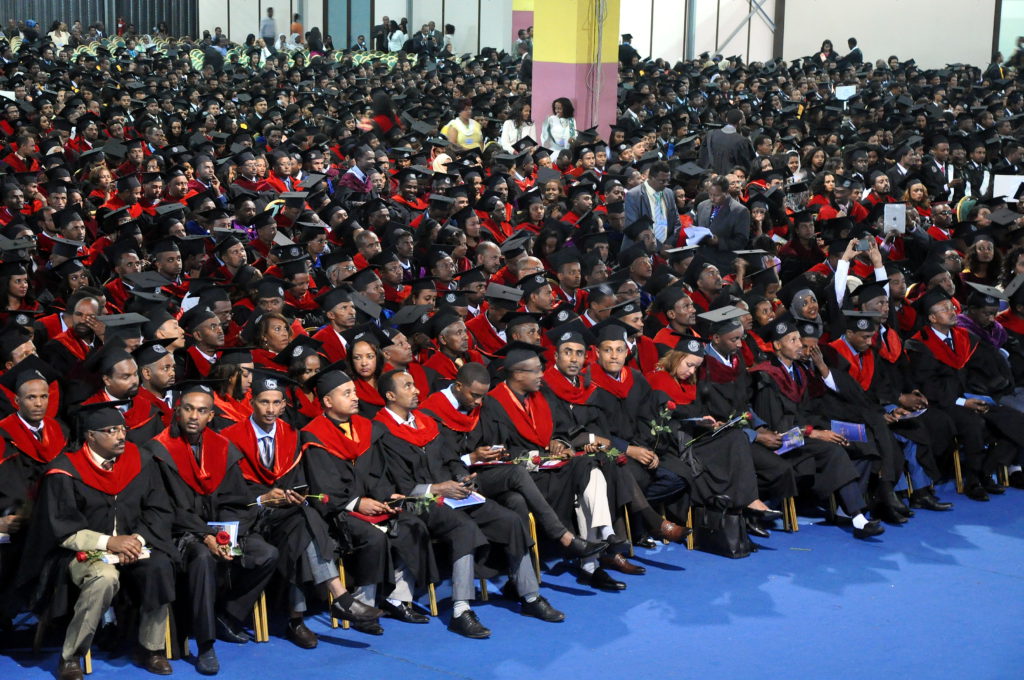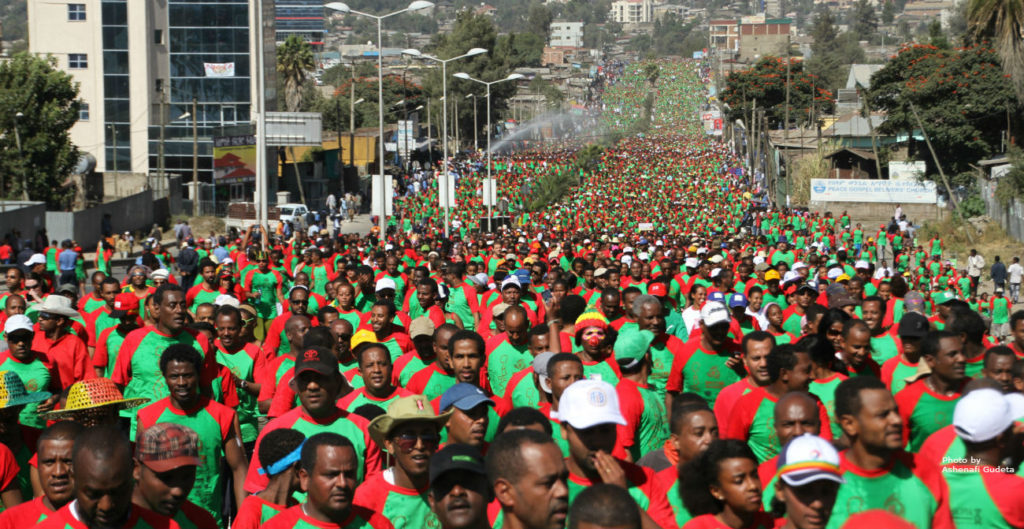
This article was originally published in The Ethiopian Messenger, the quarterly magazine of the Embassy of Ethiopia in Brussels.
Since the downfall of the Derg regime in 1991, Ethiopia has achieved impressive results in terms of living conditions of its people. This was only possible after a decade devoted to reconstruction of the country and stabilization of its institutions and another fifteen years during which sectors such as education and health were dramatically developed.
When the military dictatorship of the Derg was overthrown on 28 May 1991, many saw this day as the beginning of the end. Several politicians and political analysts, both in Ethiopia and around the globe, expressed their deep concerns that the country, sooner or later, would balkanize and disintegrate into several smaller States. Such conclusions did not come from nowhere. The country was in predicament: Ethiopia was one of the poorest countries in the world, had experienced almost 50 years of protracted civil war and had never implemented democratic values for several years, resulting in tensions between its various ethnic groups. Those factors, coupled with the existence of armed groups and the proximity of the ever turbulent Horn of Africa region made many assumed that Ethiopia would not be able to escape disintegration.
Despite these hardships, the ruling coalition party EPRDF and most importantly, the majority of the Ethiopian people shared the vision of a better and prosperous Ethiopia ahead of them and worked hard to make it a reality. The challenges and achievements of the past 25 years can be divided into two periods: the first 10 years (1991-2001) and the last 15 years (2002-2015).
1991-2001
The first 10 post-war years were devoted to the reconstruction and stability of the country, by rehabilitating the huge dismantled army personnel of both the military regime and of the incumbent Government-EPRDF; negotiating with the various armed and non-armed political parties, negotiating a new form of government; drafting and ratifying the Constitution, implementing the peaceful secession of Eritrea from Ethiopia and later, defending the sovereignty of the country against the aggression of the Eritrean military on Ethiopia in 1998. Alongside those essential activities, two main economic policy papers namely ‘Sustainable Development and Poverty Reduction Program (SDPRP, 1995-1997) and Poverty Alleviation and Sustainable Development Program (PASDEP, 1998-2002) were issued to fix the dwindling economy and reduce poverty.
2002-2015
The beginning of this period was full of challenges. The central committee of one of the founding members of the ruling party, the TPLF, divided in two and many amongst the faction group turned against the ruling party. On the other hand, this situation gave the ruling party an opportunity to establish clear policies and strategies on important issues, such as its political ideology (the revolutionary democracy) its economic philosophy (the developmental democratic State), on foreign relations and security, agricultural and industrial development, good governance, education and health and many other areas.
Discussions and consultations on those policies and strategies were held at all levels of the society. The results registered in different sectors were miraculous.
Political Achievements
The main cause behind the protracted civil war that shake Ethiopia for the last centuries, and specially from 1900 onwards, was the lack of acknowledgment of Ethiopia’s ethnic, linguistic, cultural and religious diversity. Several attempts to create a ‘one language, one people of Ethiopia’ had failed consistently because the existing reality in the country does not allow to do so. Regrettably, such attempts not only caused the country to sink deep into poverty and backwardness, but also claimed the lives of many precious sons and daughters of Ethiopia. The ruling party realized early that any governing institution committed to bring sustainable peace and stability to the country had to accept this diverse reality and create a political system able to accommodate the different ethnicities, give equal opportunity to all to decide on the issues of the country and, most importantly, leave the free choice to become ‘Ethiopian’ to each and every ethnic groups in the country.
Another important issue worth mentioning here is that, throughout the country’s history, the Ethiopian people has believed, and some still believe, that power comes from heaven, which pushed the people to blame themselves for any fault committed by their leaders. If a ruthless king or leader reigned on the country, the people concluded that the almighty God had punished them for their sins by giving them such a brutal ruler. In consequence, instead of joining forces to topple such leader, they only prayed for a divine intervention.
Until 1991, Ethiopia had never experienced a popular election to choose a leader, nor had there been the possibility of forming political parties to advance the people’s diverse opinions. In fact, at some point, Emperor Haileselassie had even decreed that “the people and land of Ethiopia belongs to the king”. One of the tasks of the EPRDF, the incumbent ruling party was therefore, to sensitize and create awareness that power is not coming from heaven, and that the people is the real owner of power. This was a revolution compared to what the people used to believe in.
In view of giving the free choice to the people of Ethiopia, the EPRDF adopted a federal democratic system that enabled each region and ethnic group to freely elect their leaders in their respective administrations, send their representatives to the National Parliament and the House of Federation, give them the right to assume responsibility in the federal structures, and to decide on the matters of their country alongside their fellow Ethiopians.
Today, there are 79 regional and nationwide political parties legally registered in Ethiopia. Out of them, 57 have participated in the last national election in 2015. Despite the lack of coherence, perseverance, seriousness and the mixing of legal and illegal activities by some members of opposition parties, (in my opinion, only one party is in a serious business of politics) in 2005, the opposition managed to gain nearly 1⁄4 of the seats within the National Parliament. Since 1991, Ethiopia has conducted five national and several regional elections in a peaceful, free and transparent manner. Knowing that power is now in the hands of the people, millions are coming out to cast their votes. Unlike before 1991, Ethiopians are now freely airing their opinions and disagreements through different means.
Alex De Waal, in his article “Is the era of great famines over?” published on 8 May 2016 in the New York times, summarized the political achievements of the country as follows: “famine isn’t caused by overpopulation, and as Ethiopia’s experience shows, it’s not a necessary consequence of drought. Politics creates famine, and politics can stop it.”
Foreign Relations

Today, Ethiopia enjoys a very positive and solid relation with all countries without distinction from North to South and East to West. It has ensured its stability and has become a regional peace anchor in terms of peace negotiations, notably in Somalia and South Sudan, and in peacekeeping missions. It has participated in eight UN peacekeeping missions since 1991, is currently serving in four missions and is the largest contributor of peacekeeping troops in the world. Ethiopia is actively playing its role in international fora, notably in the area of climate change, migration and on the fight against terrorism. Ethiopia is also home to more than 800,000 refugees.
The Economic sector
New World Encyclopedia had described Ethiopia in 1991 as follows “in this ancient land, with a proud history, the real challenge now that a cruel and despotic regime has been overthrown is to feed, educate and house the people including those displaced by the Eritrean-Ethiopian War. This may qualify as a war that had to be waged, to overthrow a cruel regime.”
Indeed, the Ethiopian Government had to wage a war to dismantle the deeply rooted poverty and backwardness from the country. The popular slogan of the Ethiopian Government since then is that “The number one, number two and number three enemy of Ethiopia is poverty”. The fight against poverty was a monumental challenge. Not only the physical poverty was immense, but also the perception that the people had of poverty had to be transformed, as most of the people were living in agreement with poverty. A revolution of mentality had to take place in order to create the required change. The Government opened discussion forums, “Ethiopian Renaissance” being at the center of all the discussions both at the leadership level and the population at large.
Those consecutive discussions have helped the Ethiopian population to look back to their proud history, to compare it with the current despicable situation of poverty and provoked them to revolt against poverty. It helped them to understand that they deserved a better life than what they were actually in. The late Prime Minister Meles Zenawi owes us honor for his invaluable role in shaping the ideas, and provoking the people and his administration to revolt against poverty. At some point, he described the poverty in Ethiopia as a big rolling stone descending from a very high mountain in a very high speed. Those who fail to run faster than the rolling stone get destroyed by it. He urged that the leadership and the people should run faster than the monster (the poverty) to rescue the country and the people from failure. And it worked: Ethiopia has a totally different image today.
According to the World Bank report on Ethiopia, “Ethiopia’s Great Run: The Great Acceleration and How to Pace It” published in February 2016, economic growth increased from 0.5% in 1981-92 to 4.5% in 1993-2004 to an average of 10.9 from 2004-2014. Those tangible performances have been achieved through the adoption and implementation of a series of structural economic reforms. The report went on saying that poverty declined substantially from
55.3% in 2000 to 33.5% in 2011. The recent performance assessment of the Growth and Transformation Plan I indicated that poverty had declined to nearly 22% at the end of 2015. Despite this rapid growth, Ethiopia managed to remain one of the most equal countries in the world with a Gini coefficient of consumption of 0.3 in 2015. The report acknowledged that progress went beyond monetary dimensions. Life expectancy had been increasing by about one year annually since 2000 and is now higher than in the low income countries and Sub-Saharan African averages. According to the report, Ethiopia has surpassed many of the Sub-Saharan African countries in several other key development indicators, including child and infant mortality, and as a result, Ethiopia has attained most of the Millennium Development Goals, the report ascertained.
Ethiopia has witnessed a complete transformation of the structure of its economy. As in many developing countries, agriculture previously had dominant role in the economy, but today the service sector dominates the economy with 46% of GDP as compared to 40% for agriculture. Tax to GDP ratio has reached 13% from almost none in 1991. Domestic saving showed an amazing increase to reach around 22%. The total road coverage has reached 120,000 km. 70% of the Ethiopian villages have connected with roads and 96% of the country is covered with telephone network.
The country has also registered commendable achievements in the field of energy production, infrastructure, housing program and employment opportunity among others. Energy production has increased to more than 3870 MW at the end of 2015 from less than 200 MW in 1991. Five hydroelectric dams and two wind energy fields were constructed in the past 25 years, and an expansion on the wind energy, new projects in the thermal and solar energy and more dams are underway.
Education
Under the “Education for all” moto, each kebele in Ethiopia is now entitled to one primary school, two to three secondary schools and at least to one preparatory school in each woreda (district). Overall, there are 42,330 elementary-secondary schools (from only 4,278 primary and secondary schools in 1991) and more than 26 million students in school in the country (compared to 2 million out of a population of 48 million in 1991). Primary school coverage has reached 96%, and 41% of secondary school age students are in school. As the reader might be aware of, only South Africa and Egypt have achieved 100% primary school coverage in Africa. The two countries took 40-50 years to reach that level. But according to the current performances, Ethiopia could reach the same level in only 27 years: the Ethiopian Ministry of Education projects to reach 100% primary school coverage by 2018. Most importantly, Ethiopian children are today studying in their mother tongue, and 51 different languages are used as mediums of instruction in primary schools.

In 1991, there were only two universities in Ethiopia. Today, there are 36 public universities and this number will increase to 44 at the end of the second Growth and Transformation Plan (2015-2020). Private higher education has also increased as part of the general liberalization of the economy. There are now approximately 66, starting from no single one in 1991. Private institutions offering undergraduate degree programs in Ethiopia and the private sector accounts for approximately 25 percent of the country’s undergraduate enrollments.
As part of the 70/30 strategy, (70% natural science and 30% social sciences) the Government has established 10 technology institutes and two science and technology universities. All in all, there are more than 600,000 students in the Ethiopian universities today.
On the other hand, in view of educating youths who fail to pass to higher educations with different skills and techniques, 324 public and 516 private Technical and Vocational Education Training institutions (TVET) have been created, which enroll 288,000 students.
Health

Ethiopia’s health policy is focused on prevention. With the moto of “1 for 25,000”, one health center for twenty- five thousand residents, Ethiopia has achieved incredible results in the health sector in the past 25 years. According to the Ethiopian Ministry of Health, in 1991, the country’s health coverage was 38% and has now reached 99%. The death rate due to communicable diseases such as tuberculosis, HIV and yellow fever has been reduced substantially. The following table presents key indicators of the achievements in the last 25 years.

Furthermore, the number of mothers’ death during labor has dropped to 353/100,000 from 1400/100,000 and child & infant mortality has reduced by 70%.
Those are some of the main achievements accomplished in the past 25 years. They have not only changed the image and wellbeing of Ethiopia and its people, but most importantly, they have inspired youngsters to revolt against poverty and to commit themselves to do whatever is necessary to win against it. But this doesn’t mean that everything is perfect. There are still immense challenges to be overcome. 22% of the population is still living under poverty and nearly 80% of the population are living in rural areas mostly depending on rain fed agriculture. The ever increasing demand of the society for improved good governance, increased supply of energy and potable water, will require immediate and accelerated actions. But again, when looking at the recently launched fight against corruption and maladministration coupled with the commitment and determination of the Ethiopian people and leadership; it appears clearly that Ethiopia has a very bright future ahead to live and to enjoy its Renaissance.




